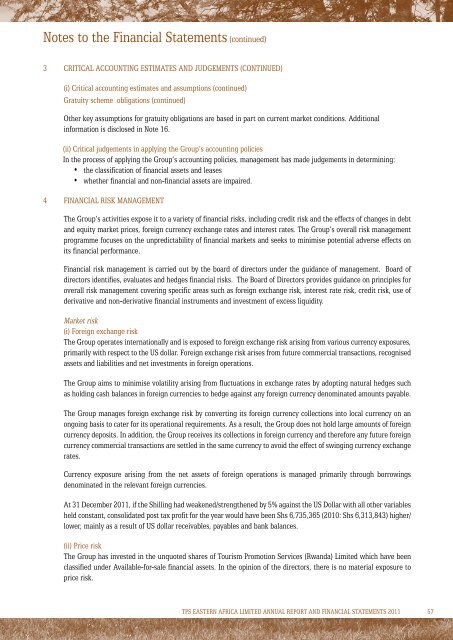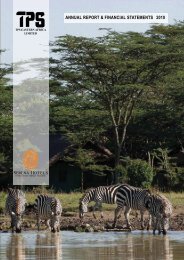2012 TPSEA Annual Report - Serena Hotels
2012 TPSEA Annual Report - Serena Hotels
2012 TPSEA Annual Report - Serena Hotels
Create successful ePaper yourself
Turn your PDF publications into a flip-book with our unique Google optimized e-Paper software.
Notes to the Financial Statements (continued)<br />
3 Critical accounting estimates and judgements (continued)<br />
(i) Critical accounting estimates and assumptions (continued)<br />
Gratuity scheme obligations (continued)<br />
Other key assumptions for gratuity obligations are based in part on current market conditions. Additional<br />
information is disclosed in Note 16.<br />
(ii) Critical judgements in applying the Group’s accounting policies<br />
In the process of applying the Group’s accounting policies, management has made judgements in determining:<br />
• the classification of financial assets and leases<br />
• whether financial and non-financial assets are impaired.<br />
4 Financial risk management<br />
The Group’s activities expose it to a variety of financial risks, including credit risk and the effects of changes in debt<br />
and equity market prices, foreign currency exchange rates and interest rates. The Group’s overall risk management<br />
programme focuses on the unpredictability of financial markets and seeks to minimise potential adverse effects on<br />
its financial performance.<br />
Financial risk management is carried out by the board of directors under the guidance of management. Board of<br />
directors identifies, evaluates and hedges financial risks. The Board of Directors provides guidance on principles for<br />
overall risk management covering specific areas such as foreign exchange risk, interest rate risk, credit risk, use of<br />
derivative and non-derivative financial instruments and investment of excess liquidity.<br />
Market risk<br />
(i) Foreign exchange risk<br />
The Group operates internationally and is exposed to foreign exchange risk arising from various currency exposures,<br />
primarily with respect to the US dollar. Foreign exchange risk arises from future commercial transactions, recognised<br />
assets and liabilities and net investments in foreign operations.<br />
The Group aims to minimise volatility arising from fluctuations in exchange rates by adopting natural hedges such<br />
as holding cash balances in foreign currencies to hedge against any foreign currency denominated amounts payable.<br />
The Group manages foreign exchange risk by converting its foreign currency collections into local currency on an<br />
ongoing basis to cater for its operational requirements. As a result, the Group does not hold large amounts of foreign<br />
currency deposits. In addition, the Group receives its collections in foreign currency and therefore any future foreign<br />
currency commercial transactions are settled in the same currency to avoid the effect of swinging currency exchange<br />
rates.<br />
Currency exposure arising from the net assets of foreign operations is managed primarily through borrowings<br />
denominated in the relevant foreign currencies.<br />
At 31 December 2011, if the Shilling had weakened/strengthened by 5% against the US Dollar with all other variables<br />
held constant, consolidated post tax profit for the year would have been Shs 6,735,365 (2010: Shs 6,313,843) higher/<br />
lower, mainly as a result of US dollar receivables, payables and bank balances.<br />
(ii) Price risk<br />
The Group has invested in the unquoted shares of Tourism Promotion Services (Rwanda) Limited which have been<br />
classified under Available-for-sale financial assets. In the opinion of the directors, there is no material exposure to<br />
price risk.<br />
TPS EASTERN AFRICA LIMITED ANNUAL REPORT AND FINANCIAL STATEMENTS 2011 57





